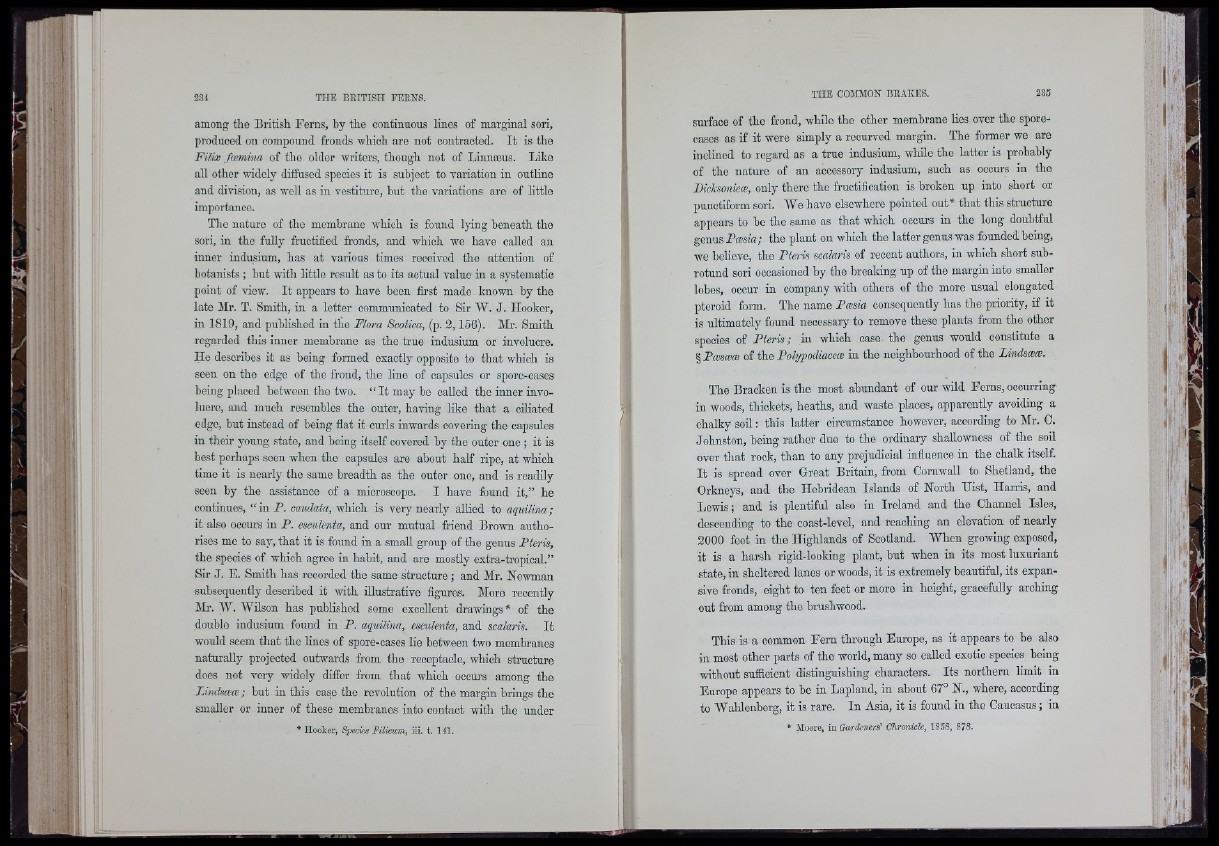
ii H
'■r-
A
■J.'
I
i-i
. ;i'
i i
I
'i'4' *;
■ i' .
■ ' J f
among tho British Ferns, by tho continuous lines of marginal sori,
produced on compound fronds which aro not contracted. It is the
Filix foemina of tho older writers, though not of Linnoeus. Like
all other widely diffused species it is subject to variation in outline
and division, as well as in vostiture, but the variations are of little
importance.
Tho nature of tho membrane which is found lying beneath the
sori, in tho fully fructified fronds, and which wo havo called an
inner indusium, has at various times received tho attention of
botanists ; hut with littlo result as to its actual value in a systematic
point of view. It appears to have been first made known by the
late Mr. T. Smith, in a letter communicated to Sir W . J. Hooker,
in 1819, and published in tho Flora Sootica, (p. 2,156). Mr. Smith
regarded this inner membrane as the true indusium or involucre.
Ho describes it as being formed exactly opposite to that which is
seen on tho edge of the frond, the line of capsules or spore-cases
being placed between the two. “ It may bo called the inner involucre,
and much resembles the outer, having like that a ciliated
edge, but instead of being flat it curls inwards covering the capsules
in their young state, and being itself covered by the outer one ; it is
best perhaps seen when tho capsules are about half ripe, at which
time it is nearly the same breadth as the outer one, and is readily
seen by the assistance of a microscope. I have found it,” he
continues, “ in P . caudata, which is very nearly allied to acquilina;
it also occurs in P. escuJenta, and our mutual friend Brown authorises
me to say, that it is found in a small group of the genus Pteris,
the species of which agree in habit, and are mostly extra-tropical.”
Sir J. E. Smith has recorded the same structure ; and Mr. Newman
subsequently described it with illustrative figures. More recently
Mr. W. "Wilson has published some excellent drawings* of the
double indusium found in P. aquilina, esculenta, and scalaris. It
would seem that the lines of spore-cases lie between two membranes
naturally projected outwards from the receptacle, which structure
does not very widely differ from that which occm-s among the
Lindsoeoe; hut in this case the revolution of the margin brings the
smaller or inner of these membranes into contact with the under
* Hooker, Specks Filicum,, iii. t. 141.
surface of tho frond, whilo tho other membrane lies over the spore-
cases as if it were simply a recurved margin. The former we are
inclined to regard as a true indusium, while the latter is probably
of the nature of an accessory indusium, such as occurs in tho
Picksoniece, only there the fructification is broken up into short or
punctiform sori. We have elsewhere pointed out* that this structure
appears to be the same as that which occurs iu the long doubtful
genus Pissia; the plant on which tho latter gonus was founded being,
wo believe, the Pteris scalaris of recent authors, in which short subrotund
sori occasioned by the breaking up of the margin into smaller
lobes, occur in company with others of the more usual elongated
pteroid form. Tho name Paisia consequently has the priority, if it
is ultimately found necessary to remove these plants from the other
species of Pteris; in which case tho genus would constitute a
§ Poesoeoe of tho Polypodiacece in the neighbourhood of tho Lindsoeoe.
The Bracken is the most abundant of our wild Ferns, occurring
in woods, thickets, heaths, and waste places, apparently avoiding a
chalky soil : this latter circumstance however, according to Mr. 0.
Johnston, being rather duo to the ordinary shallowness of the soil
over that rook, than to any prejudicial influence in the chalk itself.
It is spread over Great Britain, from Cornwall to Shetland, the
Orkneys, and the Hebridean Islands of North Uist, Harris, and
Lewis ; and is plentiful also in Ireland and the Channel Isles,
descending to the coast-level, and reaching an elevation of nearly
2000 feet in the Highlands of Scotland. "When growing exposed,
it is a harsh rigid-looking plant, hut when in its most luxuriant
state, in sheltered lanes or woods, it is extremely beautiful, its expansive
fronds, eight to ten feet or more in height, gracefully arching
out from among the brushwood.
This is a common Fern through Europe, as it appears to he also
in most other parts of the world, many so called exotic species being
without suffloiout distinguishing characters. Its northern limit in
Europe appears to he in Lapland, in about 67° N., where, according
to Wahlenherg, it is rare. In Asia, it is found in the Caucasus ; in
* Moore, in Gardeners' Chronicle, 1858, 878.
I'
( ■ ià
!
IM
4
1*
/til til
lili